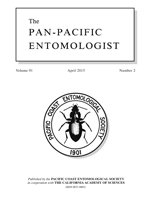The reliance of insects on ultraviolet (UV) light in nature is not well known, despite a general understanding of how insects detect UV. Chamaesyce albomarginata (Torr. & A. Gray) Small is a mat-forming euphorb common in southwestern deserts that produces small, flower-like cyathia. The plant's small size, flatness, and abundant insect visitors enabled experimentally testing the dependence of flies, bees, and wasps flying to the plant on UV light. Most insects landing on plants were minute bombyliid flies in Mythicomyia Coquillet, 1893 and Nexus Hall & Evenhuis, 1987, andrenid bees in Perdita Smith, 1853, and sphecid wasps in Solierella Spinola, 1851. Ultraviolet light is absorbed by leaves on C. albomarginata, reflected slightly more by cyathia, and moderately reflected by surrounding substrate. Decreasing UV contrast between plants and surrounding substrate by covering substrate with clear UV-absorbing film, compared with clear UV-transmitting vinyl, did not affect numbers of insects landing on plants. Placing the same film approximately 20 cm above plants and surrounding substrate decreased numbers of insects landing by 68% compared with the vinyl. Diptera and Hymenoptera responded similarly by flying beneath the UV-absorbing film and approaching plants less frequently. Absorbing UV from incident light illuminating plants appeared to eliminate a visual cue used by insects for locating flowering plants. The most likely visual cue eliminated was the pattern of polarized UV in skylight.
How to translate text using browser tools
14 July 2015
Absorbing incident ultraviolet light decreases landings by Diptera and Hymenoptera on flowering Chamaesyce albomarginata (Torr. & A. Gray) Small (Euphorbiaceae)
William D. Wiesenborn
ACCESS THE FULL ARTICLE

The Pan-Pacific Entomologist
Vol. 91 • No. 2
April 2015
Vol. 91 • No. 2
April 2015
Andrenidae
behavior
Bombyliidae
Insecta
skylight
Sphecidae
visual cues




